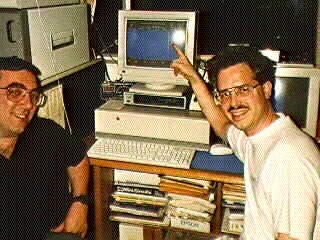|
BAMBI
Software Collection
|
Click here to download the BAMBI
Software Collection for IBM compatibles (447K).
Put this in a subdirectory on your hard drive and type 'setinew' to
expand.

Photo: BAMBI-A Waterfall Display (with a signal of terrestrial origin
being viewed by Mike F. and Bob Lash)
Below is the information contained in the collection's 'readme.1st'
file:
Project BAMBI Amateur Radio Telescope Software Collection
=========================================================
(rev. 6/26/97)
|
Hello fellow Radio Astronomy Enthusiast!
Enclosed are the latest versions of our collection of programs for the BAMBI
Radio Telescope Project. Please consider this "freeware", you may duplicate or
modify it for your own use. We would like to encourage other amateur radio
astronomers to join in the SETI effort; please let us know if we can be of
help to you.
The following programs should be present on this disk (these are for IBM's
with VGA. It should work on any PC. We were running it on a 486 DX2/66 with
1 MEG of memory, although we recently upgraded to a Pentium 133.).
BAMBIDAT.EXE (Compiled executable)
BAMBIDAT.BAS (Source code for Borland Turbo Basic Complier)
============
This program allows you to view up to 10 consecutive nights worth of drift
scan recordings and also perform time averaging. Included on this disk are
six nights of actual recordings of the CASS A supernova remnant (the files
are named bMMDDYYn.dat (b= bambi, MMDDYY = date of recording, n= a for 1st
recording that night, b = 2nd, etc, .dat= data file). To see the CASS A
scans, from the DOS prompt type:
BAMBIDAT
Then follow the menu options (press F6 for Recall State, and then type
CASS_A.CFG to select the CASS A collection of recordings. This loads
the data. Then to view, press F4 for View and Process files).
BAMBI089.EXE
BAMBI089.BAS
============
This program runs continously on the radio telescope and logs total power
readings into your chosen file at 30 second intervals. It also automatically
moves the dish to the desired declination and shows RA of the beam in real
time. It also plots the data on your VGA in "strip chart-like" style.
(Note: Since the .EXE expects to find the hardware as described in
the schematics, attempting to run it on a "detached" pc may cause
problems).
WATER.EXE
WATER.BAS
=========
Shows a simulated detection in "SETI" mode. The doppler shift caused by
Earth's rotation with respect to a distant (extraterrestrial source)
results in the type of slanted line shown. Earth's rotation causes up to a
1 hz per second drift, approximately. From the DOS prompt type:
WATER
BAMBIFFT.EXE
BAMBIFFT.BAS
============
Actual software used in "SETI" mode to monitor four thousand channels at a
time, each 1 Hz in width, and displays the results in a "Waterfall" screen
(time vs. freq bins). This runs an 8K FFT on the digitized data. It also
allows you to set the base frequency of the 810A spectrum analyzer to choose
where these channels will start (between 3.7 and 4.2 GHz in our system).
(Note: Since the .EXE expects to find the hardware as described in
the schematics, attempting to run it on a "detached" pc may cause
problems).
FFTC.EXE
FFTC.C
========
8K FFT C program called by BAMBIFFT to quickly process the FFT.
(We are planning to eventaully do this MUCH faster using an FFT chip
donated to the project called the United Technology IQMAC. It can
run up to 256K FFTs orders of magnitude faster than software approaches).
SL9_view.exe
============
A neat program that tells you the position of the Jupiter comet fragment
impact sites at any given time and date, and also contains lots of info
about SARA and BAMBI.
PLANETS.COM
===========
A terrific freeware planet locator program. Gives you the precise location
of any planet at your chosen date and time.
Have fun, and good luck with your projects!
Best Wishes,
Bob Lash
Mike Fremont
Mike F.
Project BAMBI
bob@bambi.net
BAMBI Home | What's New | Software | Jupiter Observations | SARA / Amateur Radio Astronomy
